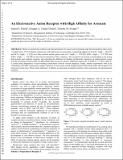| dc.contributor.author | Etkind, Samuel I. | |
| dc.contributor.author | Vander Griend, Douglas A. | |
| dc.contributor.author | Swager, Timothy M | |
| dc.date.accessioned | 2020-10-22T20:18:03Z | |
| dc.date.available | 2020-10-22T20:18:03Z | |
| dc.date.issued | 2020-07 | |
| dc.date.submitted | 2020-05 | |
| dc.identifier.issn | 0022-3263 | |
| dc.identifier.issn | 1520-6904 | |
| dc.identifier.uri | https://hdl.handle.net/1721.1/128150 | |
| dc.description.abstract | Herein, we present the synthesis and characterization of a macrocyclic polyamide cage that incorporates redox-active 1,4-dithiin units. UV/vis titration experiments with eight anions in acetonitrile revealed high affinity for H2AsO4- (log β2 = 10.4-0.4+0.4) and HCO3- (log β2 = 8.3-0.4+0.3) over other common anionic guests, such as Cl- (log K1:1 = 3.20-0.02+0.03), HSO4- (log K1:1 = 3.57-0.03+0.02), and H2PO4- (log K1:1 = 4.24-0.04+0.05), by the selective formation of HG2 complexes. The recognition of arsenate over phosphate is rare among both proteins and synthetic receptors, and though the origin of selectivity is not known, exploiting the difference in the binding stoichiometry represents an underexplored avenue toward developing receptors that can differentiate between the two anions. Additional analysis by 1H NMR in 1:3 CD2Cl2/MeCN-d3 found a strong dependence of anion binding stoichiometry with the solvent employed. Finally, titration experiments with cyclic voltammetry provided varying and complex responses for each anion tested, though reaction between the anion and receptors was observed in most cases. These results implicate 1,4-dithiins as interesting recognition moieties in the construction of supramolecular receptors. | en_US |
| dc.description.sponsorship | National Science Foundation (Grant DC-2004005) | en_US |
| dc.description.sponsorship | U.S. Army Engineer Research and Development Center (Contract W912HZ-17-2-0027) | en_US |
| dc.language.iso | en | |
| dc.publisher | American Chemical Society (ACS) | en_US |
| dc.relation.isversionof | http://dx.doi.org/10.1021/acs.joc.0c01206 | en_US |
| dc.rights | Creative Commons Attribution-Noncommercial-Share Alike | en_US |
| dc.rights.uri | http://creativecommons.org/licenses/by-nc-sa/4.0/ | en_US |
| dc.source | Prof. Swager via Ye Li | en_US |
| dc.title | Electroactive Anion Receptor with High Affinity for Arsenate | en_US |
| dc.type | Article | en_US |
| dc.identifier.citation | Etkind, Samuel I. et al. "Electroactive Anion Receptor with High Affinity for Arsenate." Journal of Organic Chemistry 85, 15 (July 2020): 10050–10061 © 2020 American Chemical Society | en_US |
| dc.contributor.department | Massachusetts Institute of Technology. Department of Chemistry | en_US |
| dc.relation.journal | Journal of Organic Chemistry | en_US |
| dc.eprint.version | Author's final manuscript | en_US |
| dc.type.uri | http://purl.org/eprint/type/JournalArticle | en_US |
| eprint.status | http://purl.org/eprint/status/PeerReviewed | en_US |
| dc.date.updated | 2020-10-08T15:01:44Z | |
| dspace.orderedauthors | Etkind, SI; Vander Griend, DA; Swager, TM | en_US |
| dspace.date.submission | 2020-10-08T15:01:48Z | |
| mit.journal.volume | 85 | en_US |
| mit.journal.issue | 15 | en_US |
| mit.license | OPEN_ACCESS_POLICY | |
| mit.metadata.status | Complete | |
